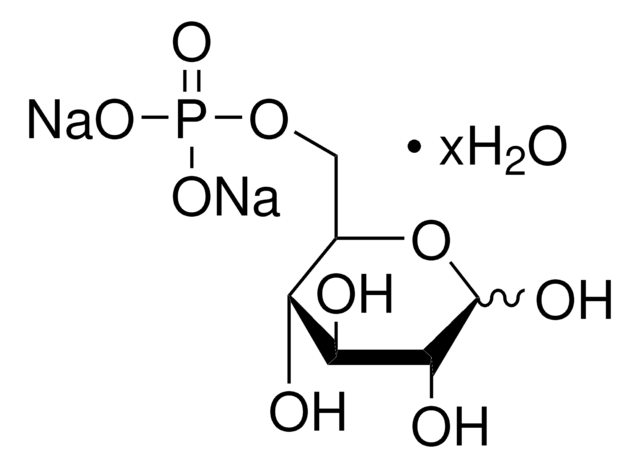G6048
Galactokinase human
recombinant, expressed in E. coli
Sign Into View Organizational & Contract Pricing
All Photos(1)
About This Item
Recommended Products
recombinant
expressed in E. coli
Quality Level
form
solution
specific activity
≥1400 unit/μg protein
mol wt
42 kDa
shipped in
dry ice
storage temp.
−70°C
Biochem/physiol Actions
Galactokinase catalyzes the phosphorylation of αD-galactose to produce galactose-1-phosphate as part of the Leloir pathway.
Physical properties
N-terminal GST-tagged 42 kDa full length protein
Unit Definition
One unit will convert 1.0 picomole of galactose to galactose-1-phosphate per minute at pH 7.4 at 30 °C.
Physical form
Supplied as a solution in 40 mM Tris-HCl, pH 8.0, 110 mM NaCl, 2.2 mM KCl, 20% glycerol, 3 mM DTT and 10-250 mM imidazole.
signalword
Danger
hcodes
Hazard Classifications
Eye Irrit. 2 - Repr. 1B - Skin Irrit. 2
Storage Class
6.1C - Combustible acute toxic Cat.3 / toxic compounds or compounds which causing chronic effects
wgk_germany
WGK 1
flash_point_f
Not applicable
flash_point_c
Not applicable
Certificates of Analysis (COA)
Search for Certificates of Analysis (COA) by entering the products Lot/Batch Number. Lot and Batch Numbers can be found on a product’s label following the words ‘Lot’ or ‘Batch’.
Already Own This Product?
Find documentation for the products that you have recently purchased in the Document Library.
P A Frey
FASEB journal : official publication of the Federation of American Societies for Experimental Biology, 10(4), 461-470 (1996-03-01)
The biological interconversion of galactose and glucose takes place only by way of the Leloir pathway and requires the three enzymes galactokinase, galactose-1-P uridylyltransferase, and UDP-galactose 4-epimerase. The only biological importance of these enzymes appears to be to provide for
Chieh Hsu et al.
Nature communications, 3, 682-682 (2012-02-23)
During evolution, genetic networks are rewired through strengthening or weakening their interactions to develop new regulatory schemes. In the galactose network, the GAL1/GAL3 paralogues and the GAL2 gene enhance their own expression mediated by the Gal4p transcriptional activator. The wiring
Sanjay K Upadhyay et al.
Journal of computer-aided molecular design, 26(7), 847-864 (2012-05-29)
The Gal4p mediated transcriptional activation of GAL genes requires the interaction between Gal3p bound with ATP and galactose and Gal80p. Though numerous studies suggest that galactose and ATP activate Gal3p/Gal1p interaction with Gal80p, neither the mechanism of activation nor the
Kajal Biswas et al.
Methods in molecular biology (Clifton, N.J.), 852, 121-131 (2012-02-14)
Recombineering is a recombination-based highly efficient method of genetic engineering. It can be used to manipulate the bacterial chromosomal DNA as well as any episomal DNA. Recombineering can be used to insert selectable or nonselectable DNA fragments and subclone DNA
Ling Lin et al.
Proceedings of the National Academy of Sciences of the United States of America, 109(6), 1997-2002 (2012-02-07)
Promoter-specific transcriptional activators (activators) stimulate transcription through direct interactions with one or more components of the transcription machinery, termed the "target." The identification of direct in vivo targets of activators has been a major challenge. Previous studies have provided evidence
Our team of scientists has experience in all areas of research including Life Science, Material Science, Chemical Synthesis, Chromatography, Analytical and many others.
Contact Technical Service

